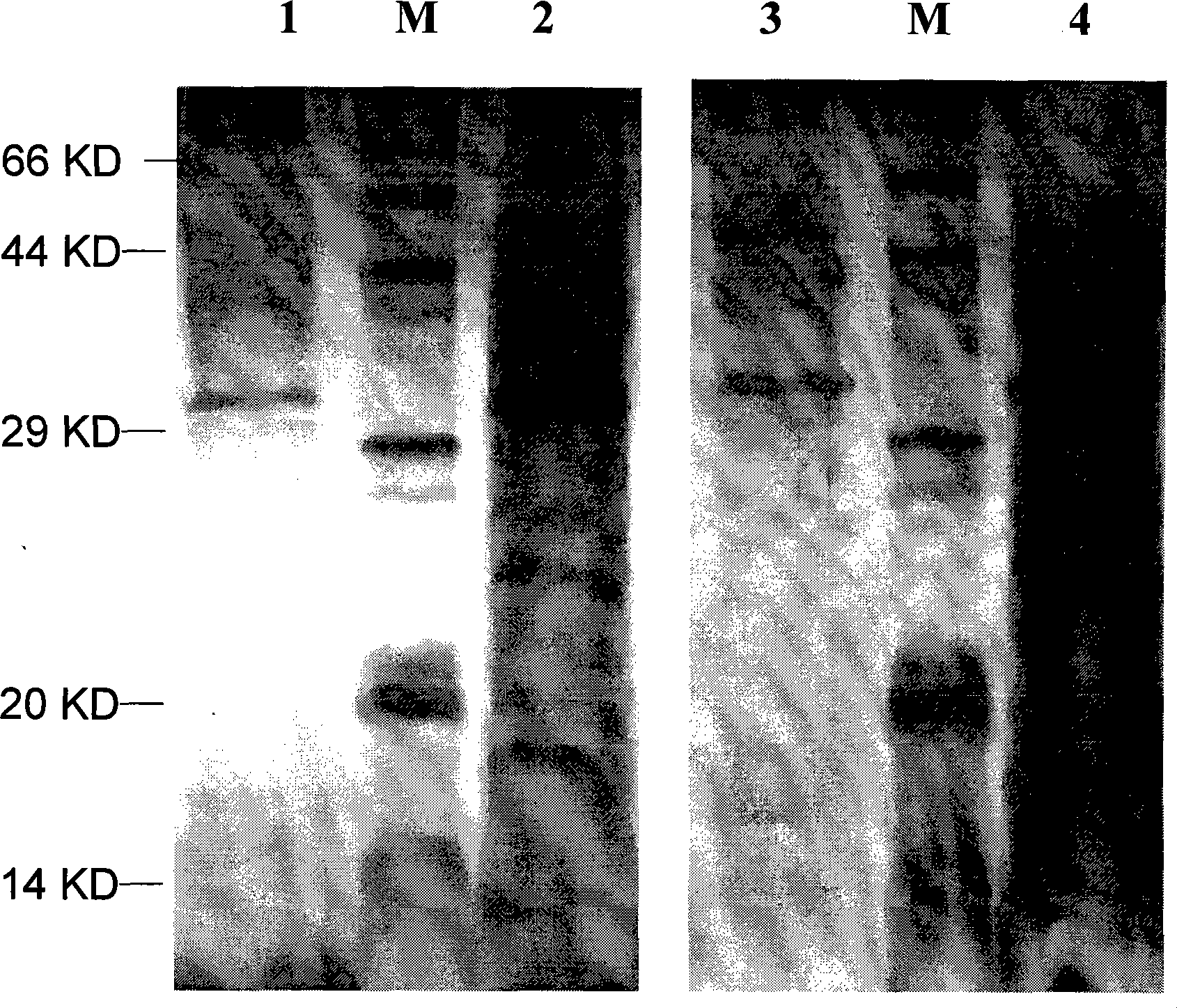Expression production and separation purification of recombinant placenta growth factor and chemical marker thereof
A placental growth factor, biotin labeling technology, applied in the field of biotechnology-recombinant genetic engineering, can solve the problems of low expression, high price and high cost of culture medium
- Summary
- Abstract
- Description
- Claims
- Application Information
AI Technical Summary
Problems solved by technology
Method used
Image
Examples
Embodiment 1
[0086] Example 1: Construction of PLGF expression vector.
[0087] 1.1 PCR amplification of human PLGF gene
[0088] The primers for PCR amplification of human PLGF gene are as follows:
[0089] Forward upstream primer (PLGF-F): ggattc GAA TTC gccttgtctgctgggaacggc
[0090] Reverse downstream primer (PLGF-R): ggattc GC GGCC GC gccgggtgcggggtctctctc
[0091] PCR amplification system:
[0092]
[0093]
[0094] PCR amplification conditions: 94°C for 5 minutes / 94°C for 30 seconds, 55°C for 30 seconds, 72°C for 40 seconds, a total of 20 cycles.
[0095] After the PCR amplification of the gene was completed, a small amount was taken and analyzed by agarose gel electrophoresis. There was an amplified band at about 400 bp, and the fragment size was consistent with the expected PLGF131 gene fragment.
[0096] 1.2 Construction and identification of PLGF-pPic9K plasmid
[0097] The PCR amplified fragment and the pPic9K plasmid were double digested with EcoR I and Not I r...
Embodiment 2
[0098] Example 2: Expression Vector Transformation of GS115 Host Bacteria and Induced Expression of PLGF Protein
[0099] 2.1 The pPic9-PLGF1 plasmid was prepared in 100ml of bacterial liquid by alkaline lysis-PEG purification. For specific steps, refer to the relevant chapters of "Molecular Cloning III".
[0100] 2.2 Take two tubes of about 15ug pPic9-PLGF1 plasmid and linearize them thoroughly with 30U Sal I and 30U Bgl II respectively. After digestion, the plasmid was precipitated with ethanol and redissolved with 5ul ultrapure sterile deionized water.
[0101] 2.3 Preparation of GS115 Competent Cells
[0102] (1) Inoculate a single clone in 3ml YPD medium and culture overnight at 30°C
[0103] (2) Put 300ul of the above-mentioned fresh bacterial solution in 300ml YPD medium at 30°C
[0104] Incubate for 18 hours. At this time, the OD value is about 1.3.
[0105] (3) Bacteria were collected by centrifugation at 1500 g for 5 minutes, and then resuspended with 300 ml of...
Embodiment 3
[0128] Example 3: SDS-PAGE detection and analysis of recombinant PLGF protein secreted and expressed by yeast cells
[0129]SDS-PAGE and ELISA methods were used to detect, analyze and identify the recombinant PLGF protein secreted and expressed in the yeast cell supernatant. After 48-96 hours of induced expression in the transformed GS115 yeast host, the supernatant was collected and loaded (reduced with DTT, or unreduced without DTT) to 12% SDS-PAGE gel electrophoresis for analysis. After the electrophoresis, the PAGE gel was stained with silver to visualize the protein, and the results were as follows: figure 2 Shown: Compared with the negative control yeast supernatant (swimming lanes 1 and 3), the pPic9-PLGF1 transformed yeast supernatant sample has a specificity of about 20-25KD under the condition of adding DTT reduction (swimming lane 4) protein band, which is consistent with the molecular weight of the predicted recombinant PLGF protein monomer; while in the unreduce...
PUM
 Login to View More
Login to View More Abstract
Description
Claims
Application Information
 Login to View More
Login to View More - R&D
- Intellectual Property
- Life Sciences
- Materials
- Tech Scout
- Unparalleled Data Quality
- Higher Quality Content
- 60% Fewer Hallucinations
Browse by: Latest US Patents, China's latest patents, Technical Efficacy Thesaurus, Application Domain, Technology Topic, Popular Technical Reports.
© 2025 PatSnap. All rights reserved.Legal|Privacy policy|Modern Slavery Act Transparency Statement|Sitemap|About US| Contact US: help@patsnap.com



